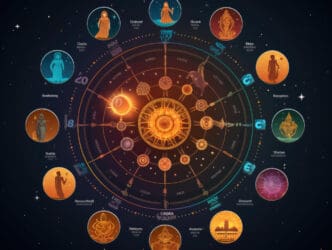Vedic Astrology offers a profoundly detailed system for understanding human destiny, and at its heart lies the indispensable tool of the Divisional Charts, known as Vargas. While the main birth chart (the Rasi or D1 chart) provides the foundational blueprint of a person’s life, the Vargas act as a set of high-powered lenses, each designed to magnify and clarify a specific area of existence—from marriage and career to wealth and spirituality. For any serious student or practitioner of Jyotish, understanding these charts is what separates a surface-level reading from a truly insightful analysis, revealing the subtle karmic patterns and underlying strengths or weaknesses that govern our experiences. These charts are derived through a precise mathematical division of the 30-degree zodiac signs, creating sixteen primary “sub-charts” that provide the granular detail necessary for accurate predictions and profound self-awareness.
What Are Divisional Charts (Vargas)?
In Vedic Astrology, the birth chart, or Rasi chart (D1), is the snapshot of the heavens at the moment of your birth. It maps the positions of the planets across the twelve zodiac signs and houses, outlining the broad strokes of your personality, potential, and life path. However, each house and planet in the D1 chart holds dominion over a wide range of life areas, making it difficult to isolate a single topic with perfect clarity.
This is where the Vargas come in. The word Varga in Sanskrit means “division” or “part.” A divisional chart is created by mathematically dividing each of the twelve zodiac signs into a specific number of segments and then creating a new chart based on which segment each planet falls into. This process essentially “zooms in” on a particular facet of the main chart’s promise.
Think of it like a high-resolution photograph. The D1 chart is the full picture, showing the entire scene. The Varga charts are like zooming in on specific details—the expression on a person’s face, the texture of a flower petal, or the inscription on a distant building. Without these magnified views, crucial details that give the full picture its true meaning would be lost.
The Shodashvarga: The Sixteen Primary Divisions
The classical sage Parashara, a foundational figure in Vedic Astrology, outlined sixteen primary divisional charts, known as the Shodashvarga. While all sixteen have their purpose, modern astrologers typically focus on a handful of the most critical ones for a comprehensive reading. The strength and placement of planets within these charts reveal the true quality and ultimate manifestation of that area of life.
A planet that appears strong in the main Rasi chart might be weak or poorly placed in a relevant divisional chart, indicating that the initial promise may not fully materialize or will face significant obstacles. Conversely, a planet that seems average in the D1 chart could be exceptionally well-placed in a Varga, indicating hidden strength and eventual success in that domain.
The Navamsa (D9): The Chart of Dharma and Marriage
After the Rasi chart (D1), the Navamsa is universally considered the single most important divisional chart. The word Navamsa means “ninth division,” as it is created by dividing each sign into nine equal parts of 3 degrees and 20 minutes each. Its primary domain is marriage, the spouse, and relationship harmony. The 7th house, the planet Venus, and the condition of the Navamsa chart itself provide a complete picture of one’s marital destiny.
However, its significance extends far beyond marriage. The Navamsa is also called the “fruit” of the Rasi chart’s “tree.” It reveals the inner character, the subconscious spiritual drive (dharma), and the ultimate strength of the planets. It shows the results that your karma will yield in the second half of life. A planet that occupies the same sign in both the Rasi (D1) and the Navamsa (D9) is called Vargottama. This placement makes the planet exceptionally strong and capable of delivering powerful and pure results according to its nature.
The Dasamsa (D10): The Chart of Career and Achievement
The Dasamsa, or tenth division chart, is the key to understanding one’s profession, public status, and achievements in the world. It provides a detailed look at the promise of the 10th house of the Rasi chart. By analyzing the planets in the D10, an astrologer can discern the type of career that will be most fulfilling, the level of success and recognition one can expect, and the nature of one’s actions (karma) in a professional context.
Planets that are strong and well-placed in the D10, especially if they are connected to the 1st or 10th house of the D10 chart, indicate a powerful and successful career path. The planetary periods (dashas) of such planets often bring significant promotions, opportunities, and public acclaim.
The Drekkana (D3): The Chart of Siblings and Courage
The Drekkana is the third division chart and governs matters related to siblings, courage, enterprise, and personal drive. It refines the information found in the 3rd house of the Rasi chart. A strong D3 chart, with well-placed benefic planets, can indicate supportive and harmonious relationships with siblings. It also points to a person possessing great courage, confidence, and the initiative to pursue their goals.
Conversely, afflictions in the D3 chart by malefic planets like Mars, Saturn, or Rahu can suggest conflict with siblings or a lack of self-motivation and courage. It is a vital chart for understanding the dynamics of your co-borns and your own innate willpower.
The Saptamsa (D7): The Chart of Progeny and Creativity
The Saptamsa, or seventh division chart, is the primary chart for analyzing children and progeny. It provides a microscopic view of the 5th house of the Rasi chart. It can indicate the potential for having children, the health and well-being of one’s offspring, and the nature of the parent-child relationship.
Beyond literal children, the D7 chart also relates to all forms of creative legacy. This includes artistic creations, intellectual works, and any endeavor through which you pass on a part of yourself to the world. A strong D7 is often seen in the charts of prolific artists, writers, and innovators.
Other Key Varga Charts
- Hora (D2): The second division chart, which governs wealth, financial resources, and family. It helps to differentiate the promise of the 2nd house of the Rasi chart.
- Chaturthamsa (D4): The fourth division chart, relating to property, home, vehicles, and overall happiness (sukha). It is the magnified view of the 4th house.
- Dwadashamsa (D12): The twelfth division chart, which provides insight into parents, ancestry, and past life karmic patterns (samskaras).
- Shashtyamsa (D60): An advanced and highly sensitive chart created from the 60th division of a sign. It is used by expert astrologers for a very fine-tuned analysis of karma, as it is said to differentiate the destinies of twins born just minutes apart.
How to Interpret Divisional Charts
Reading Varga charts requires skill and a systematic approach. They are never meant to be read in isolation from the main Rasi chart. The D1 chart shows the promise, while the Varga charts show the quality and manifestation of that promise.
The first step is to analyze the planet’s dignity in the Varga. Is the planet exalted, in its own sign, in a friendly sign, or is it debilitated or in an enemy’s sign within the divisional chart? A planet strong in the D1 and also strong in the relevant Varga (e.g., the 10th lord strong in the D10) confirms a powerful and positive outcome for that area of life.
Next, the astrologer assesses the houses within the Varga chart itself. The Ascendant of the Varga chart and its lord are of paramount importance. The condition of the houses within the Varga provides further detail. For example, in the D10 (career chart), the 10th house signifies professional success, while the 6th house could relate to service-oriented work or workplace conflicts.
Finally, this analysis is integrated with the Dasha system (planetary periods). When you enter the major or minor period of a planet, it activates its potential as seen in both the Rasi chart and all the divisional charts. A planet that is strong in the D10 will bring career-focused events during its dasha, while a planet strong in the D9 will bring relationship and dharmic matters to the forefront.
Conclusion: The Depth Beyond the Surface
The divisional charts are a testament to the sophistication and depth of Vedic Astrology. They elevate a chart reading from a general overview to a specific, nuanced, and deeply personal analysis. By examining the Vargas, we can understand why one person with a strong 10th house becomes a CEO while another becomes a respected local craftsman, or why one person’s marriage is a source of strength while another’s is a field of challenges. They are the keys that unlock the subtle layers of our karma, offering profound guidance on how to navigate our lives with greater wisdom, clarity, and purpose.








